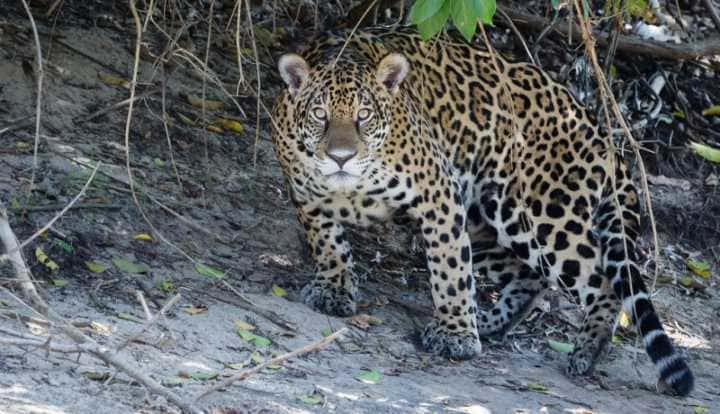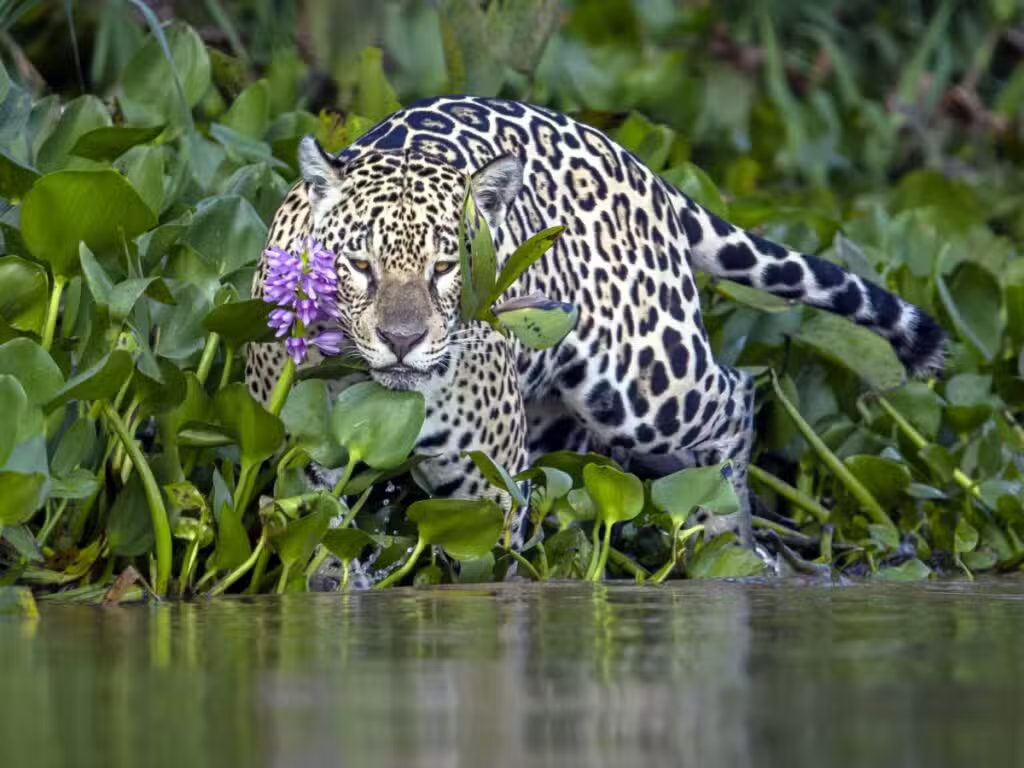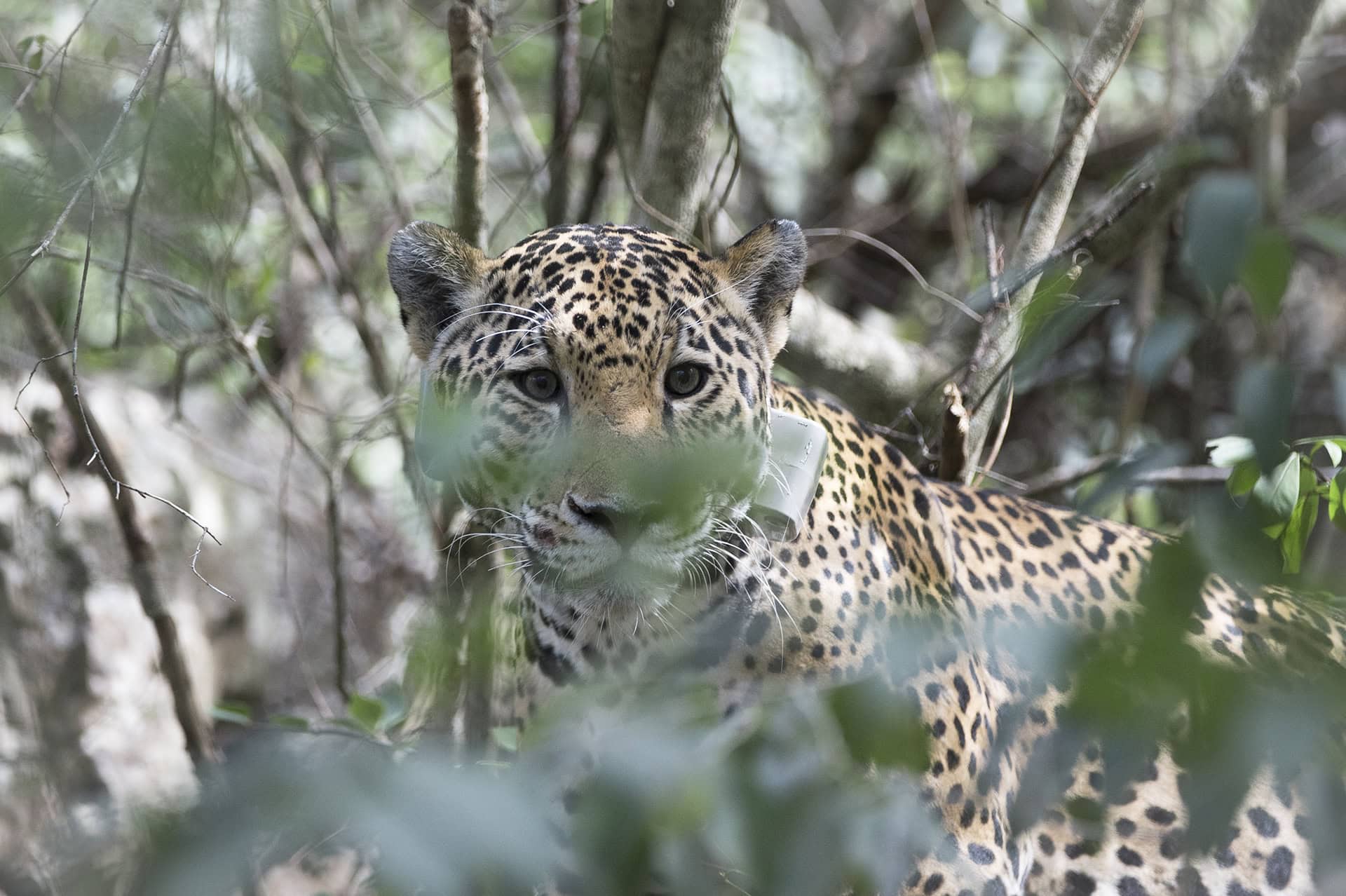Third-biggest cat on Earth, muscular and low-slung, boasting one heck of a chomp, the jaguar reigns supreme atop the wild Neotropical food web. And while catching a glimpse of this burly beast across much of its forested range is no easy feat, the Pantanal –the “Kingdom of Waters,” world’s biggest freshwater tropical wetland and a wildlife hotspot par excellence – offers unparalleled opportunities to do so. Jaguars are among the undisputed superstars of a growing regional ecotourism industry here.
For lovers of the heftiest felid in the Americas, the Instagram account of the Pantanal-based eco-tour company called Journey With Jaguars makes for highly recommended viewing. And lately some of the footage posted there has been exceptionally high on drama.
View this post on Instagram
A lot of the recent action centres around a previously undocumented big male jaguar the company calls “Tikal” and a tag-team of two younger males, “Rio” and “Manah.” Journey With Jaguars released a video on September 4 showing Tikal mating with a female jaguar just a stone’s throw away from Rio and Manah, who’d shown up on the scene to investigate the romantic ruckus: a rather unfriendly audience for “getting it on.”
Rio and Manah are cousins, Fernando R. Tortato, Brazil Conservation Program Coordinator for Panthera, the global wild cat conservation organization, told me via email. They’re also young: Rio’s three years old, Manah’s two. Tikal, by contrast, is a mature male reckoned at more than five years old, which may explain his top-dog swagger coming into the cousins’ territory.
“The bigger of the two males challenged the alpha male in a standoff that lasted hours,” Journey With Jaguars explained in its Instagram post. “All four would sit together in an area of 4 metres squared. And seem peaceful. Then they would fight ferociously. They repeated this for hours.”
The cousins are an example of a jaguar social structure that’s only recently come on the scientific radar: the male coalition. Such affiliations are well known among lions and cheetahs, but hadn’t been formally described in the jaguar, long regarded as a generally solitary cat, until a 2022 study published in Behavioral Ecology & Sociobiology, Tortato among its authors. Drawing on observations and other evidence from the Brazilian Pantanal as well as the similar seasonally flooded grassland/savannah ecosystem of the Venezuelan Llanos, the research documented multiple instances of male coalitions among jaguars, including “stable, long-lasting” examples that endured for seven or more years.
“All four would sit together in an area of 4 metres squared. And seem peaceful. Then they would fight ferociously. They repeated this for hours.”
To put things in context, though, these investigations suggested only a minority of male jaguars form such coalitions. Tortato and his co-authors postulated that high concentrations of female jags – more likely in landscapes with dense prey populations (such as the Pantanal and the Llanos), which may allow for smaller, overlapping female territories – are probably an important impetus for males to band together. Indeed, the paper notes, “spatially concentrated access to females is likely the main driver of forming male coalitions” in all three big-cat species for which they’ve been documented.
That said, this initial research hints at some significant differences in male coalitions among jaguars versus lions and cheetahs. Thus far, for instance, jaguar coalitions seem to max out at two males, whereas bigger groupings may arise in the other species (as many as 10 male lions have been documented joining forces). And as of yet there’s not much firm evidence that coalition jaguar males actively cooperate to bring down prey like their lion and cheetah counterparts, though searching for meals in tandem has been seen. (Journey With Jaguars recently posted footage of the cousin coalition squabbling over a caiman, one of Pantanal jaguars’ go-to eats.) “Although cooperative hunting in jaguars may still be documented in future studies (e.g. with the development of modern non-invasive remote observation techniques),” the authors of the Behavioral Ecology & Sociobiology paper write, “our results indicate that the main goal of male jaguar associations is to potentially gain reproductive advantages by invading other male territories and securing access to females.”
View this post on Instagram
Tortato did tell me, however, that “greater success in obtaining prey” may well be a boon for male jags in coalitions. And two male jaguars who maintained a coalition in the southern Pantanal from 2006 to 2014 were seen sharing the carcass of a tapir as well as a meal of the cannibalistic variety: a female jaguar they may have killed.
In the case of the recent Journey With Jaguars observation, Tikal seemed to come out on top of the prolonged, stop-and-start confrontation, which during its high-octane bursts was quite the noisy and violent affair. Journey With Jaguars wrote, however, that the cousins were seen on their territory a few days later and that the larger of the two ended up mating with the female jag as well.
View this post on Instagram
Tortato told me Tikal’s maturity, and the size and strength that come with it, likely explained his ability to intimidate a pair of rivals. “If it had been a coalition of adult males,” he said, “Tikal would hardly have been able to defend himself and would therefore have had to flee.”
The roughly 180,000-square-kilometre Pantanal, a UNESCO Biosphere Reserve and World Heritage Site that mostly lies within west-central Brazil but which also extends into portions of Bolivia and Paraguay, encompasses a structural sedimentary basin in the upper Paraguay River watershed. Wet-season rains send a pulse of floodwaters across this sprawling downwarp, spilling from the Paraguay and tributaries such as the Taquari and São-Lourenco-Itiquari to turn low-lying areas into vast temporary wetlands. Then, as the dry season sets in, the waters retreat to permanent rivers, lakes, and marshes. That’s the great hydrologic rhythm that defines the Pantanal ecosystem – a mosaic of grassland, savannah, and patches and galleries of forest on higher ground – and which backdrops the goings-on of its big-bodied jaguars.
Along with revelations of greater male sociality than previously appreciated, recent research out of the Pantanal has yielded insights into how female jaguars strive to avoid infanticide, including crafty mating strategies and tree-climbing.
Tortato was lead author on a 2021 study assessing the conservation status of Pantanal jaguars in the context of land-use economics. Only a small fraction of the ecosystem falls within protected reserves; the vast majority of the acreage is privately owned, most of that dedicated to low-yield cattle ranching. The perceived threat jaguars might pose to livestock raises the spectre of potential retaliatory killings of the big cat, as in so many other places where animal husbandry goes down in the presence of large carnivores. But the fact that so much of the Pantanal lowlands are seasonally flooded and thus incompatible with cattle grazing for long stretches of the year, Tortato and his co-authors noted, appears to help secure significant amounts of core jaguar habitat. Indeed, the study found that more than 60% of the Pantanal can be “considered highly suitable for the occurrence of healthy jaguar populations,” despite more than two centuries of ranching.
Ecotourism is a newer arrival on the Pantanal scene, and the researchers emphasize it can overlap with cattle ranching while increasing the perceived value of jaguars on the landscape. “In addition to boosting local income,” they wrote, “ecotourism increases diversified economic opportunities at the landholding and regional scales, and assists in the maintenance of both jaguar populations and their habitat. Perhaps the main role of ecotourism is to develop a ‘landscape of tolerance,’ where jaguars can represent financial assets rather than costs, as shown in the northern Pantanal.”
Tortato told me ecotourism in this spectacular wetland complex also has significant potential to expand scientific knowledge about jaguars, which across so much of their range are exceptionally elusive but which here, to some extent, are becoming habituated to human observers. “Jaguar tourism in Porto Jofre and other regions of the Pantanal has allowed us to make significant progress in studies on the behavioural ecology of this big cat, which until recently was recognized as a jungle animal, rarely seen in the wild, practically a ghost,” he said. “Now we have the opportunity to observe jaguars regularly and deepen our knowledge.”
That 2021 paper also highlighted the impacts of wildfire – a natural disturbance factor in the Pantanal, but one exhibiting historically unprecedented changes in timing and severity – on jaguar habitat. Record-breaking dry conditions in the region fueled extensive blazes in 2020 and again this year, when wildfires broke out in the Pantanal well ahead of the normal season, starting in late May – a month that saw close to the entire Pantanal classified under “Extreme Drought.” The 2024 fires have killed or severely injured multiple jaguars as well as giant anteaters, tapirs, and other Pantanal wildlife, and scorched important nesting habitat for the hyacinth macaw, the world’s biggest flying parrot.
This article by Ethan Shaw was first published by Earth Touch Network on 15 October 2024. Lead Image: Bart van Dorp, Flickr.
What you can do
Help to save wildlife by donating as little as $1 – It only takes a minute.







Leave a Reply